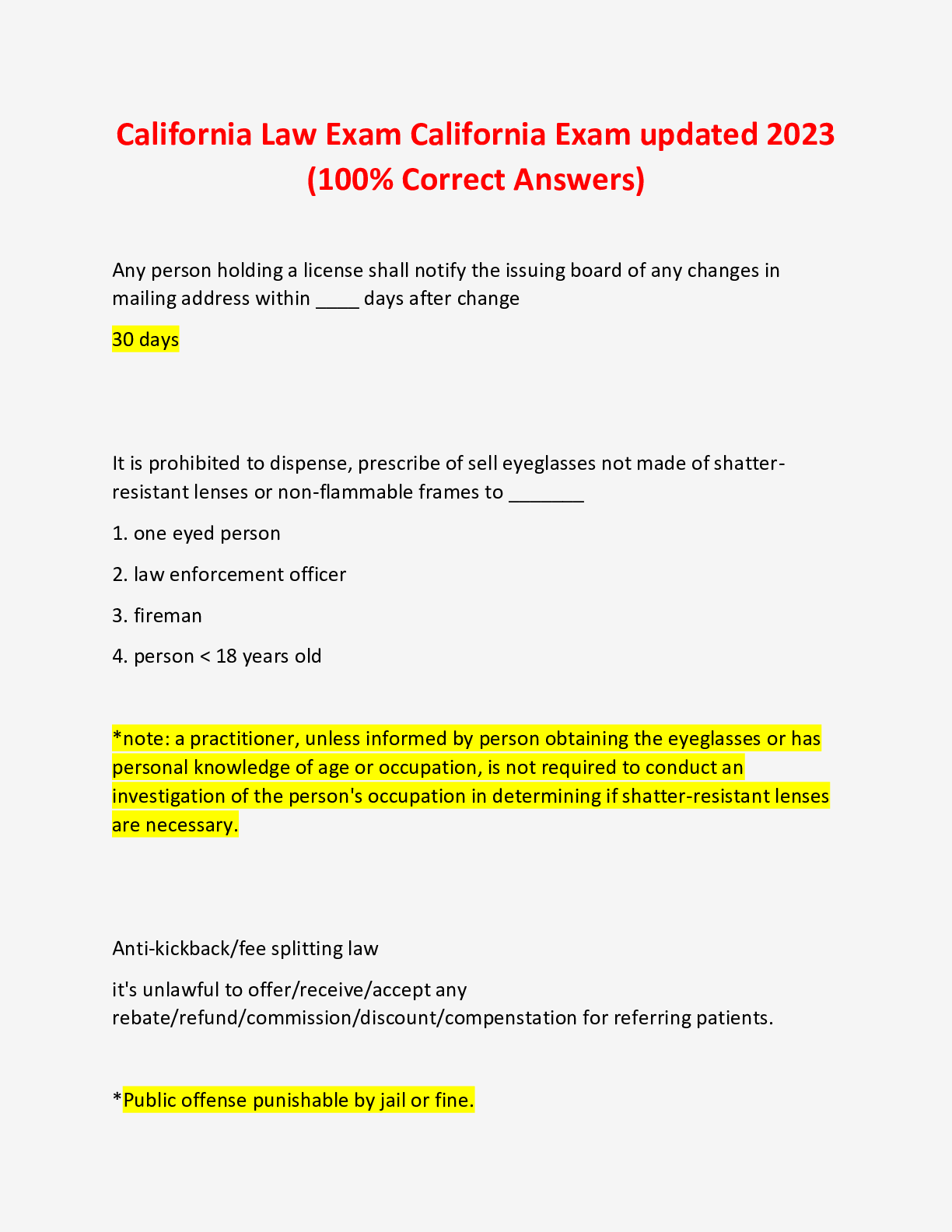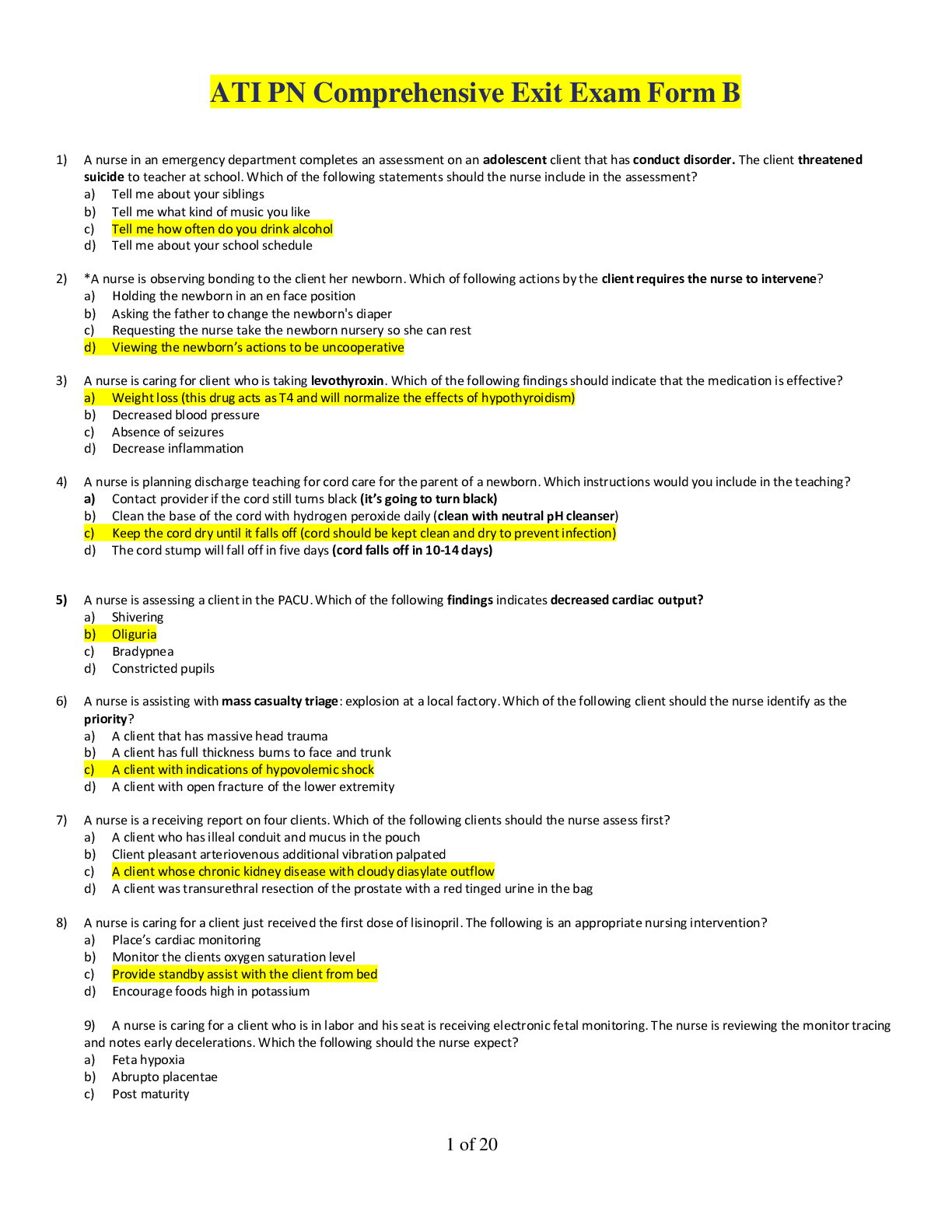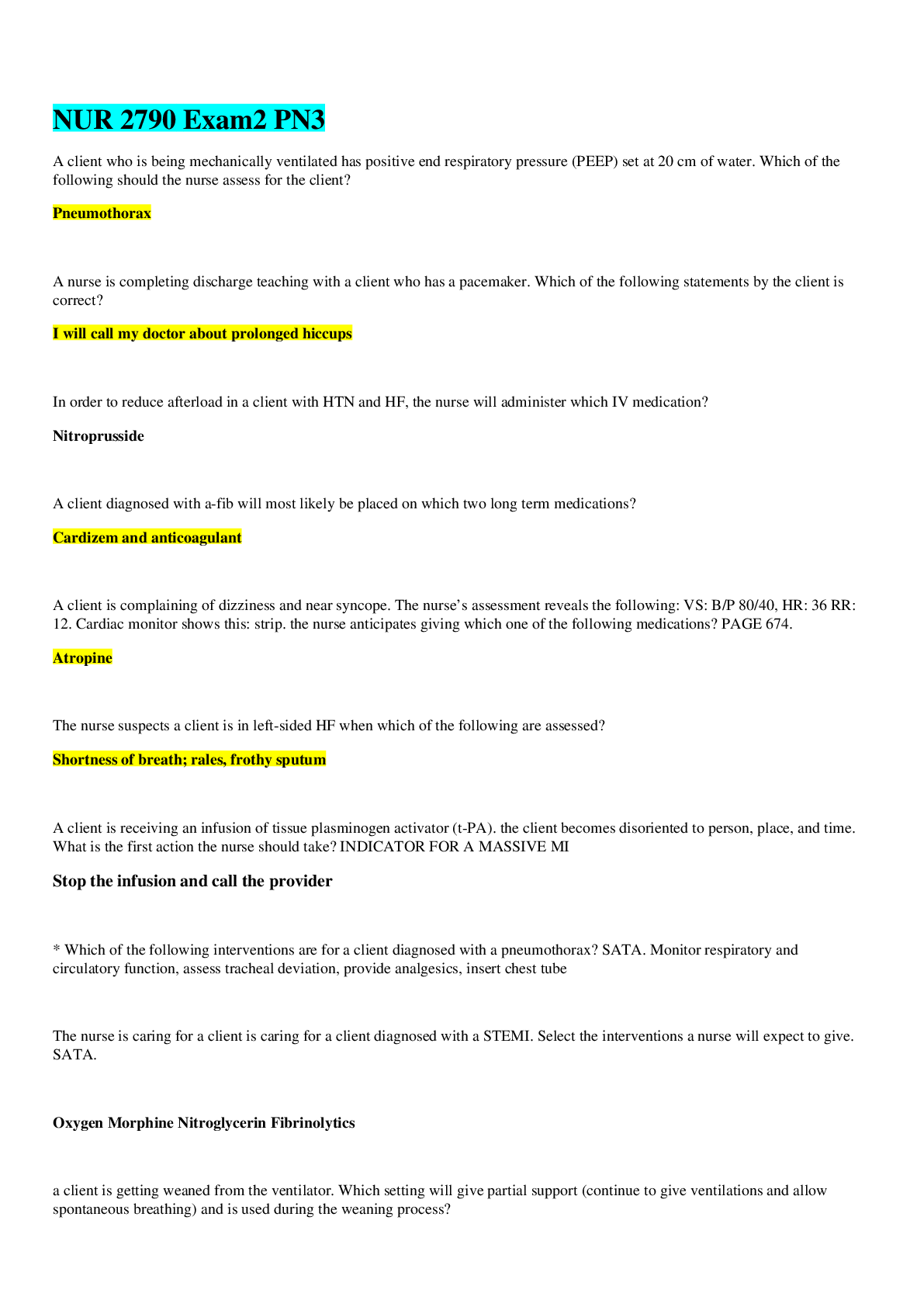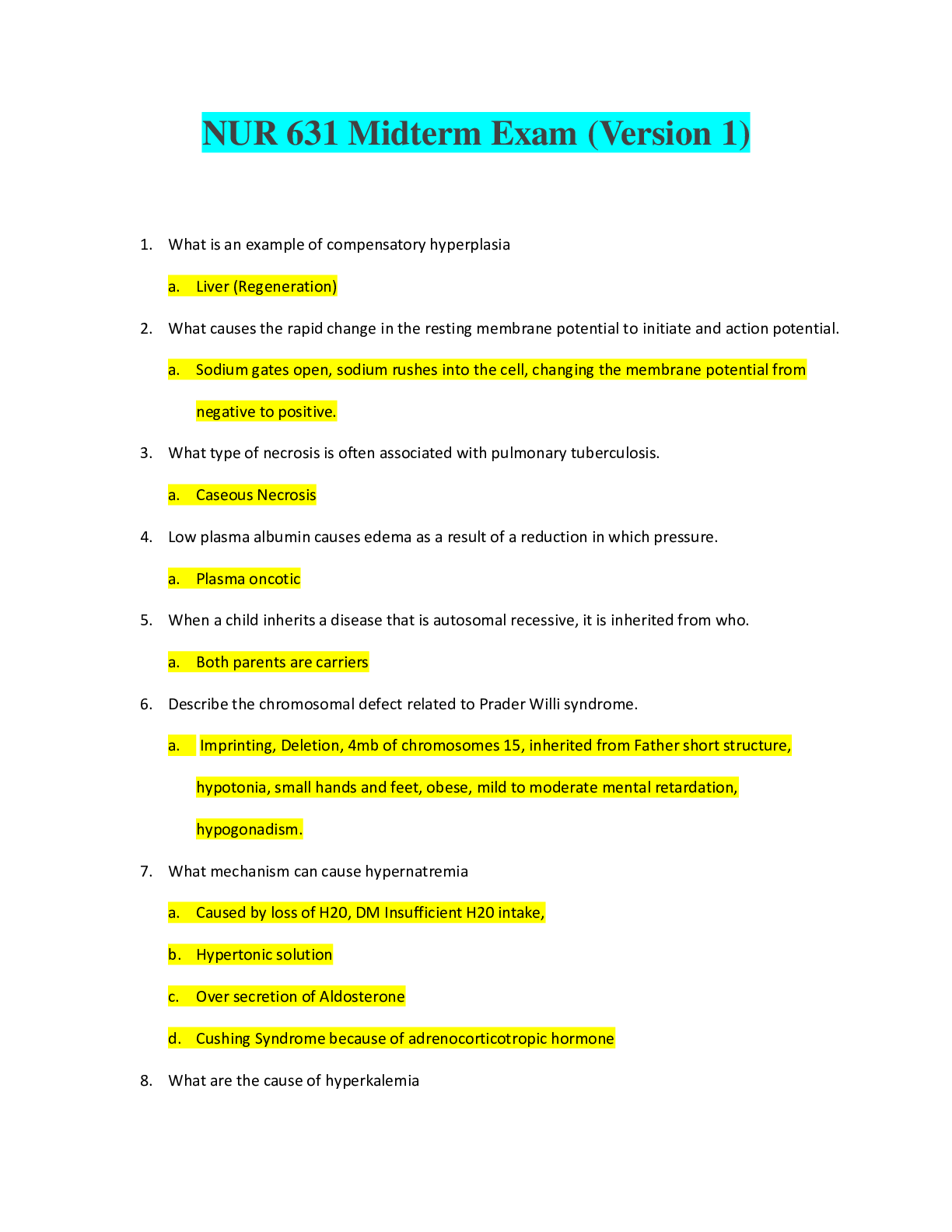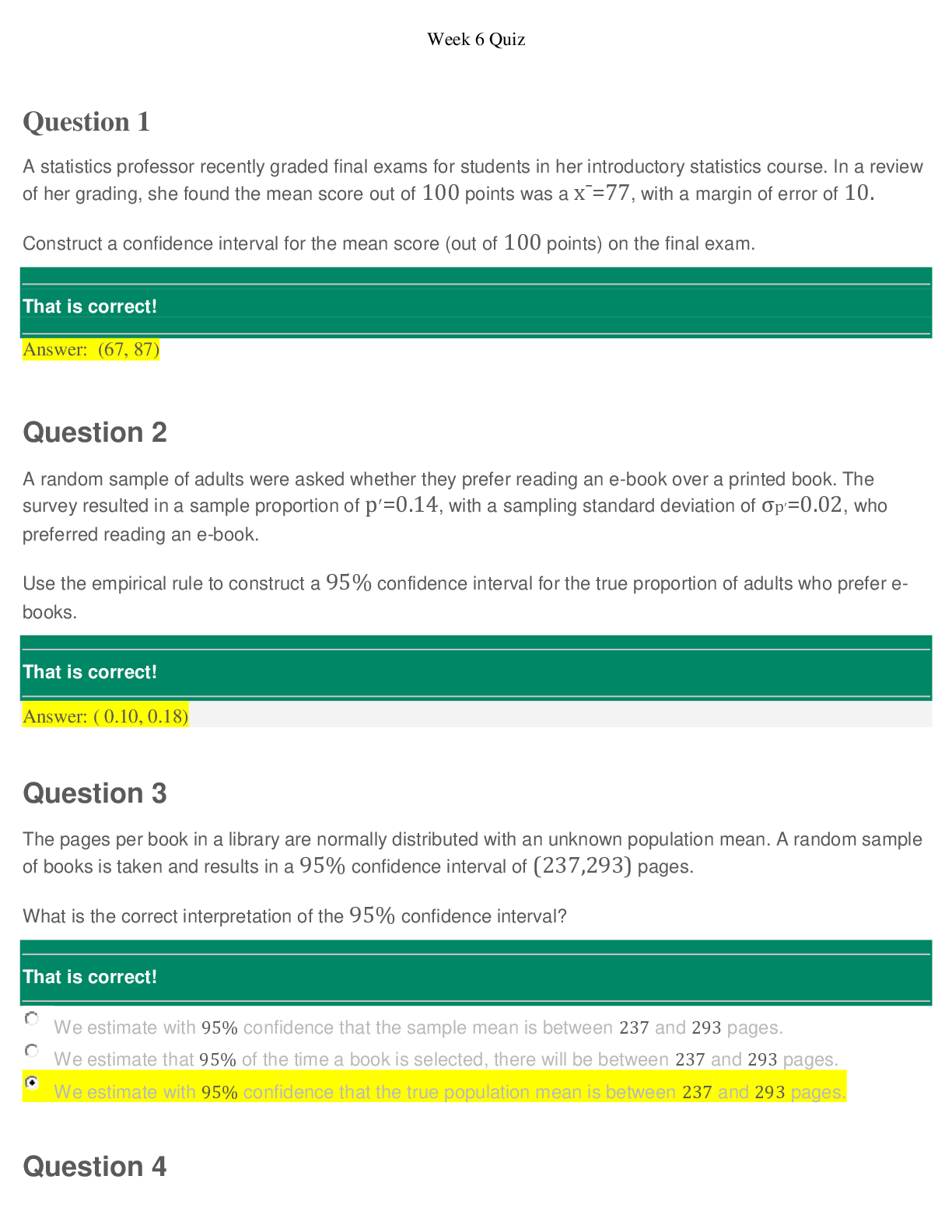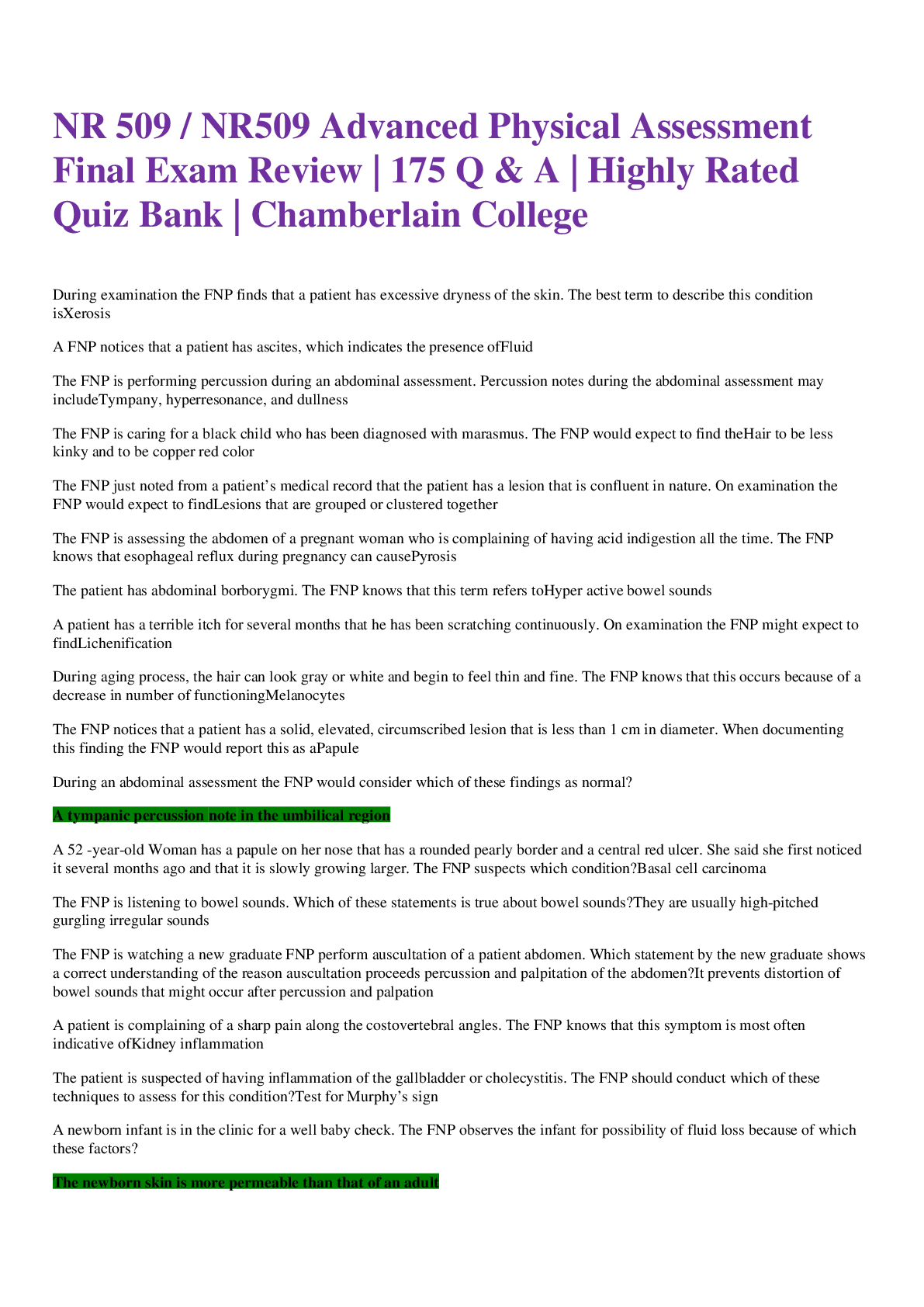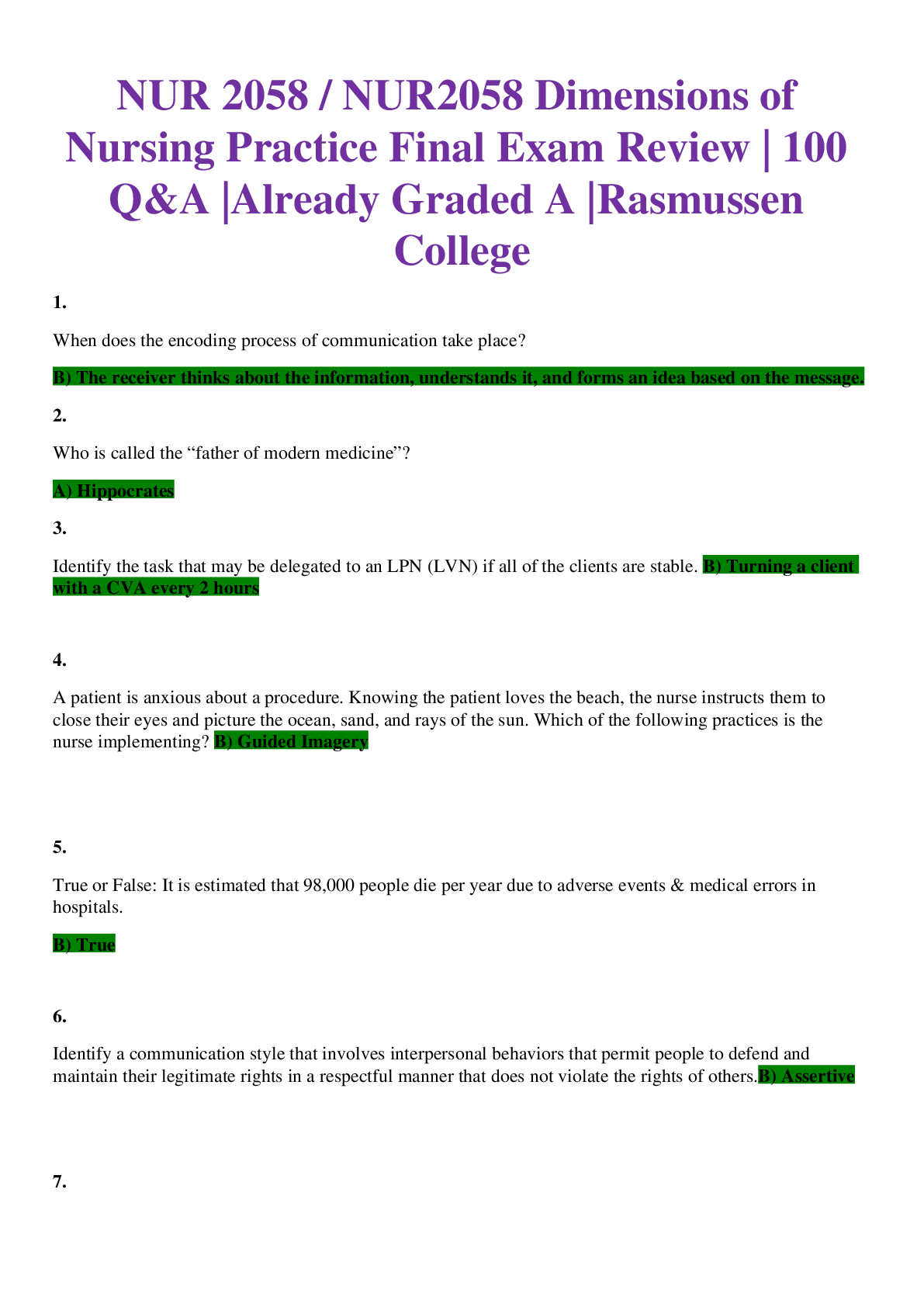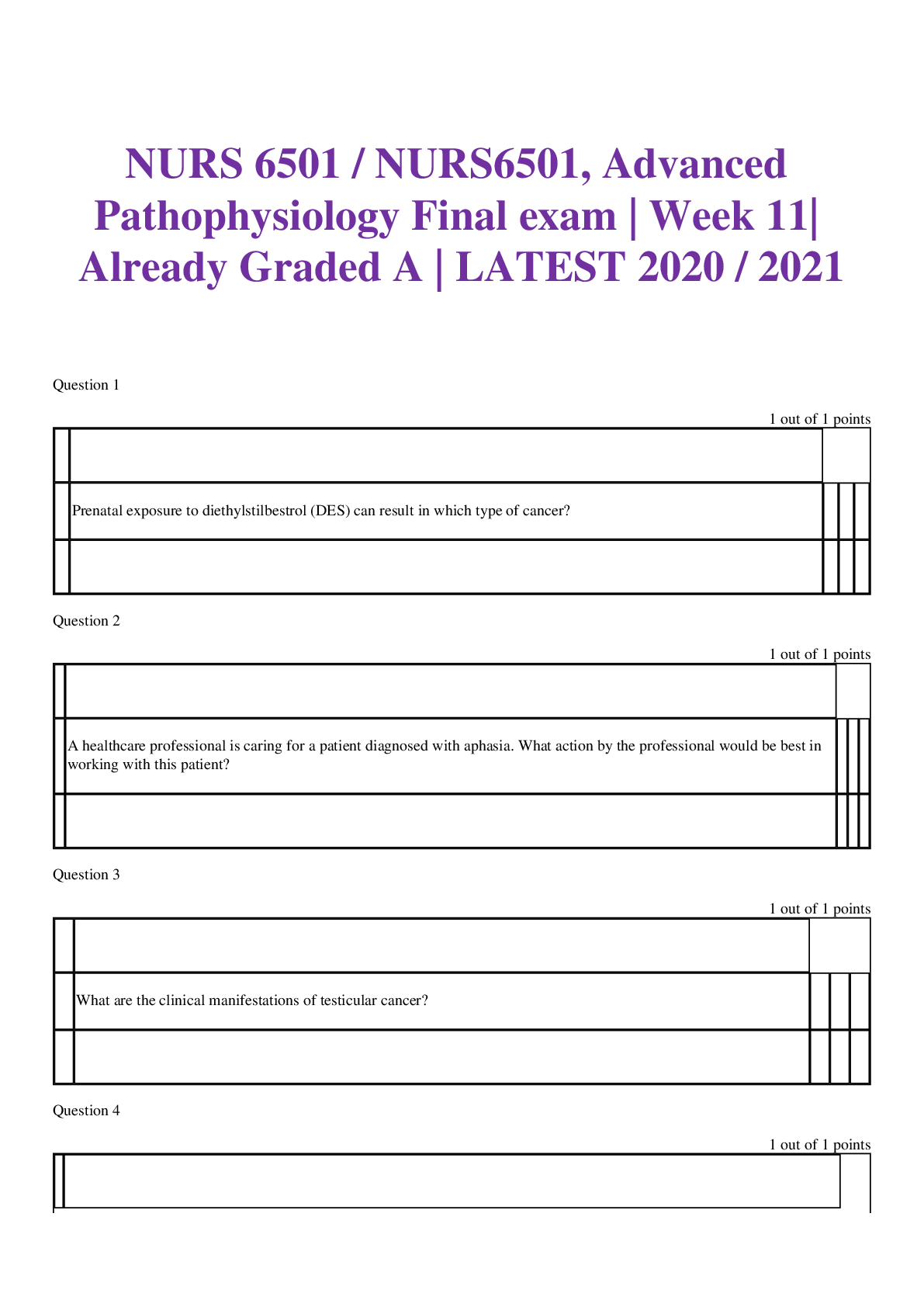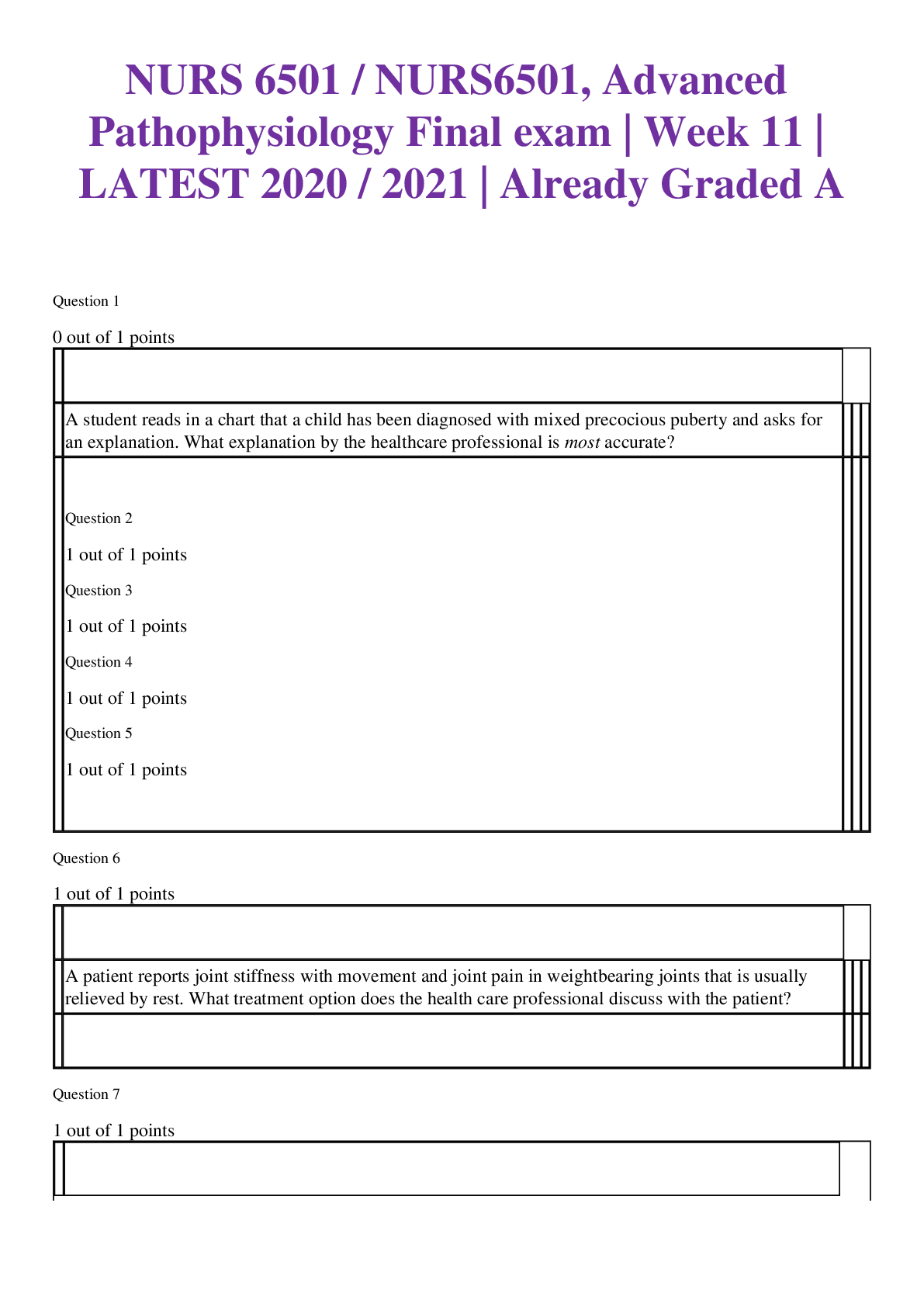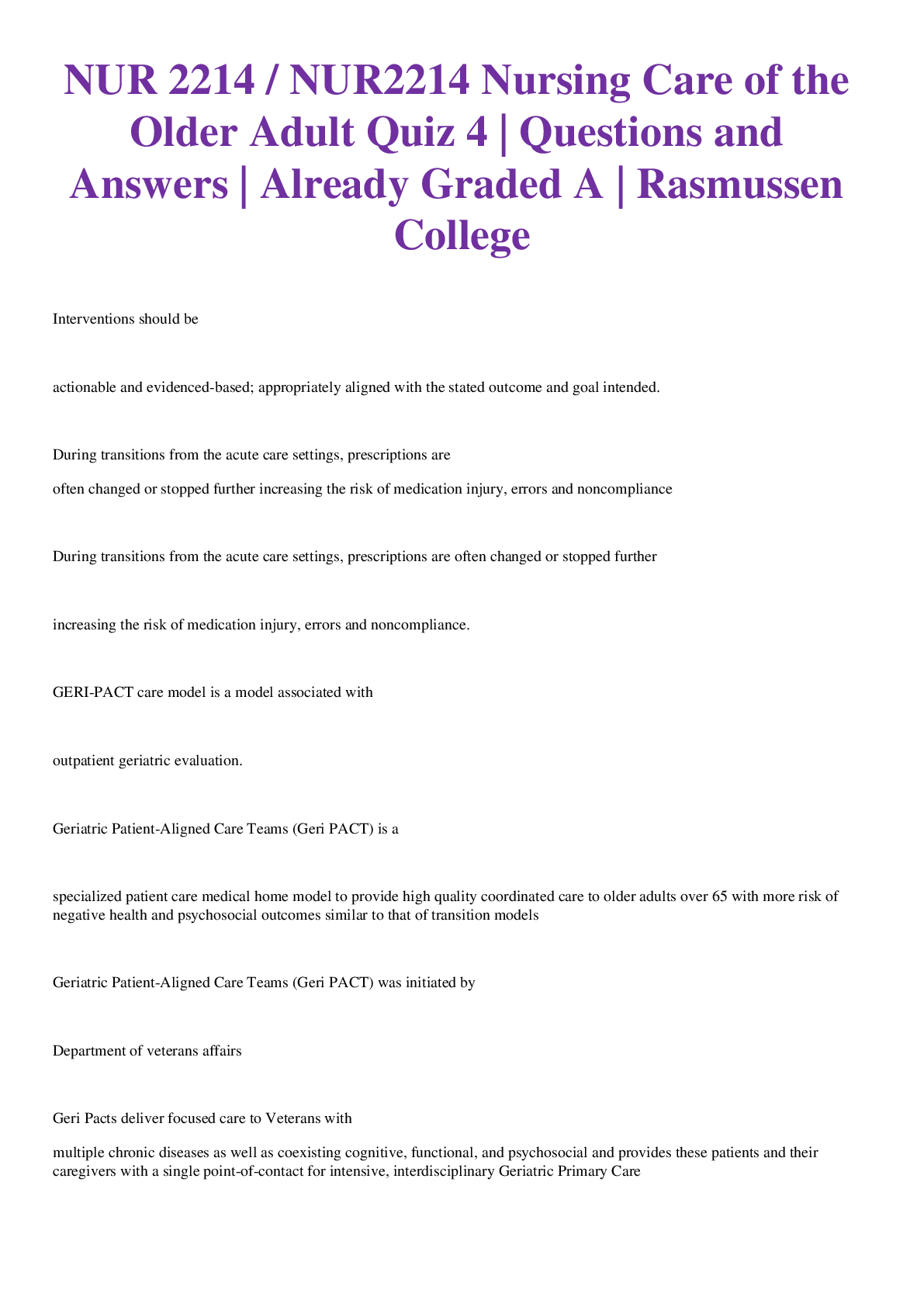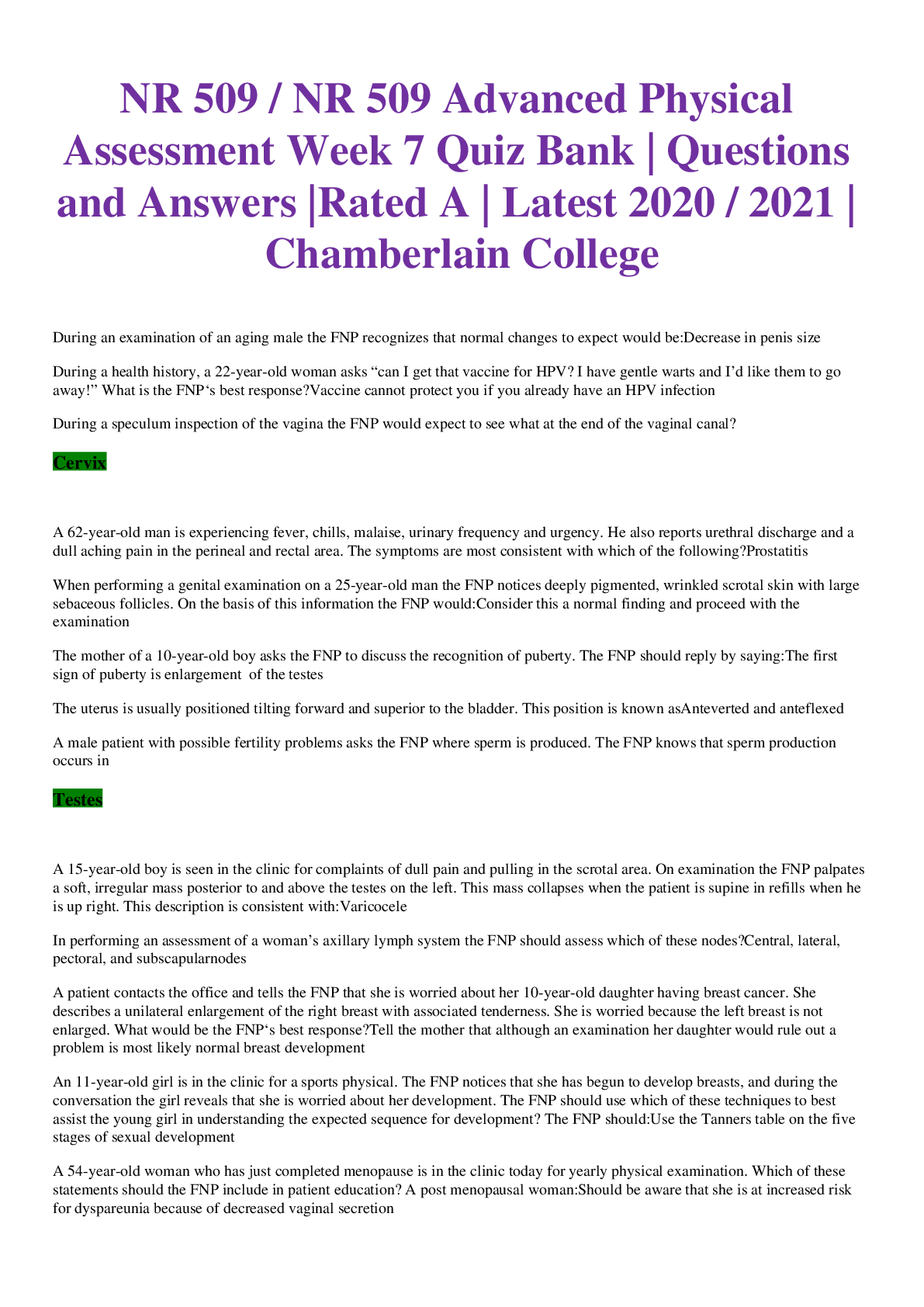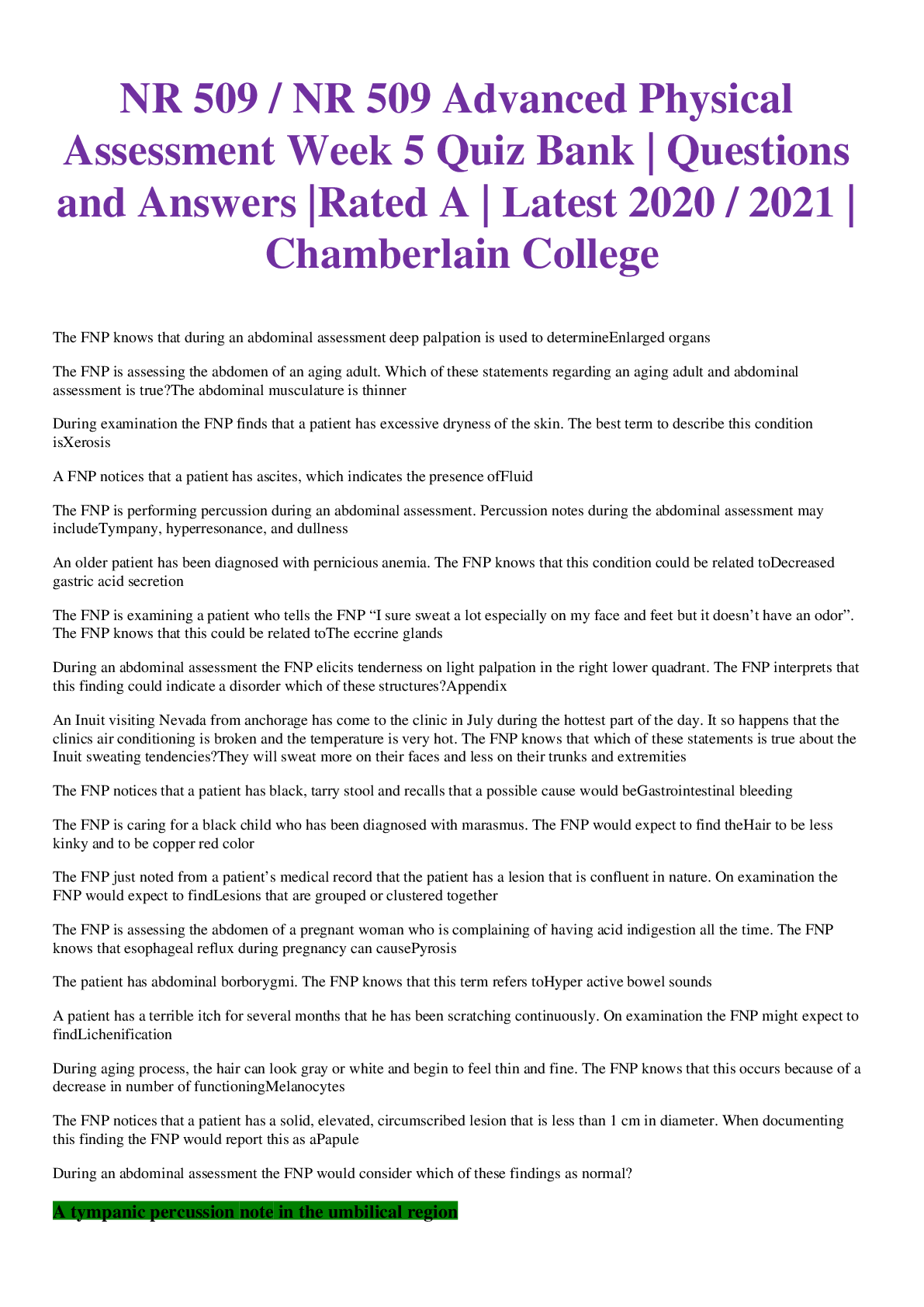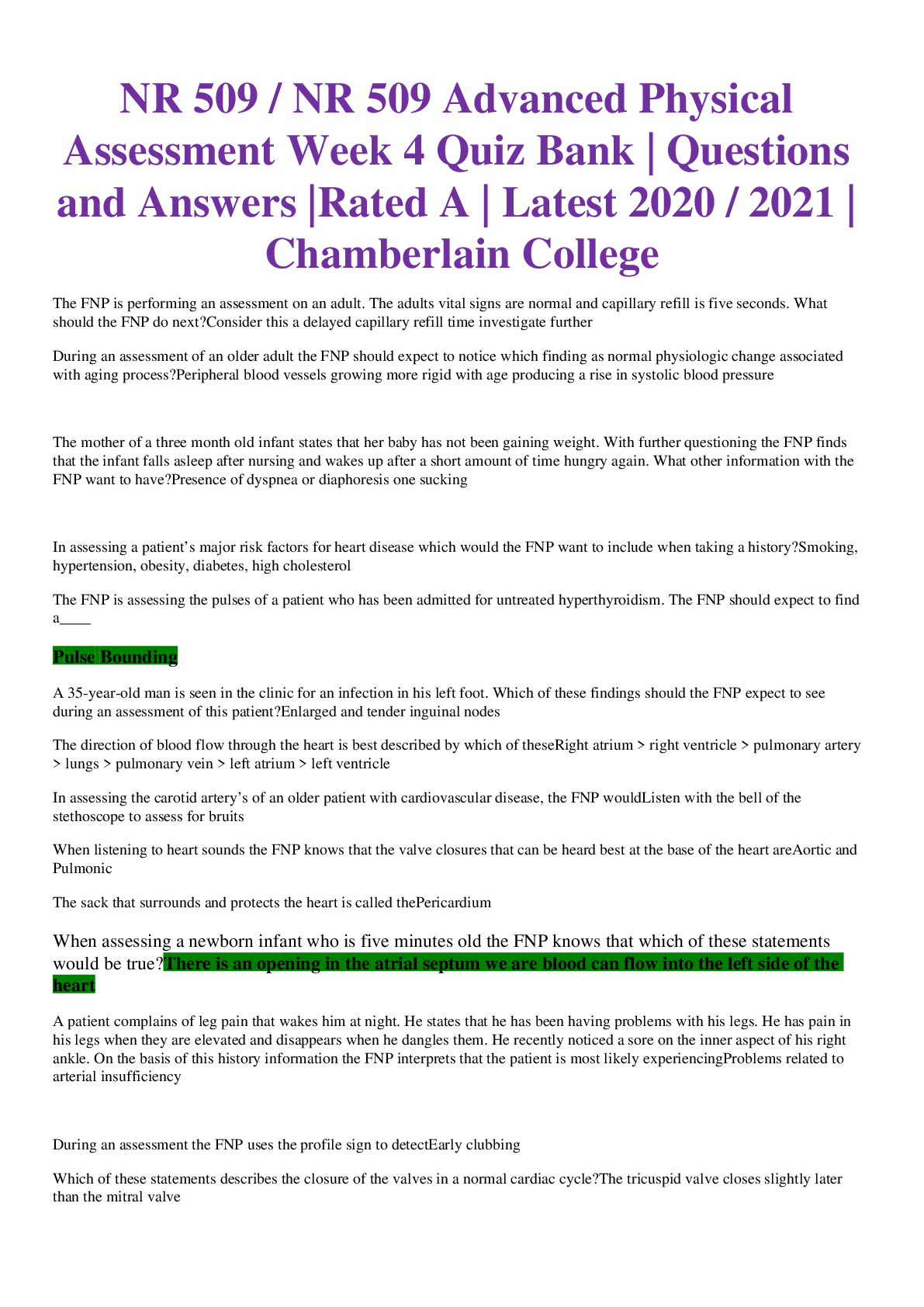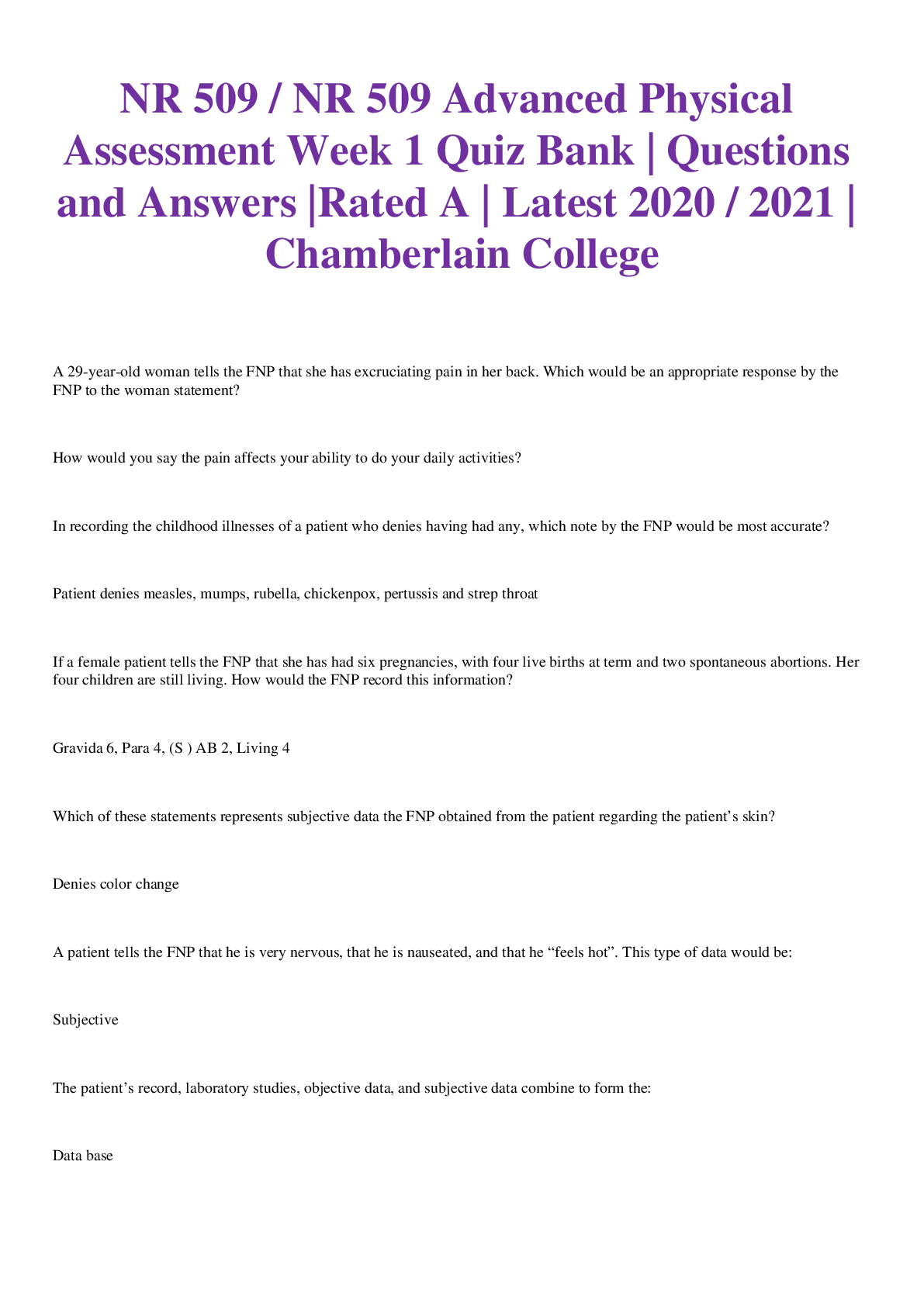*NURSING > EXAM > NURSING NR341 Exam 2 Questions and Answers | Already GRADED A | Chamberlain College of Nursing (All)
NURSING NR341 Exam 2 Questions and Answers | Already GRADED A | Chamberlain College of Nursing
Document Content and Description Below
NURSING NR341 Exam 2 Exam 2 NR 341 1. The nurse is caring for a client with hypovolemic shock. The family member asks why the fluids are being warmed. What is the Best response by the nurse? �... �to prevent complications from hypothermia” 2. The nurse is caring for a newly admitted client diagnosed with acute kidney injury. The nurse understands that the acute kidney injury is Most likely related to a history of which condition? Sepsis 3. The nurse is caring for a client being monitored by arterial pressure monitoring. The nurse notes a systolic pressure of 164 mmHg. What action should the nurse take first ? Assess the client. 4. The nurse is caring for a client with an arteriovenous (AV) fistula. Upon assessment, the nurse is unable to auscultate a bruit. What action should the nurse take first? Notify the provider 5. The nurse is assessing jugular venous pressure. In what order should the nurse proceed with the steps in the process? [place the steps in the correct order beginning with the first step 3.place head of bed between 30-45 degrees. 2. Have client turn head slightly to the left. 6. Shine a pen light across the neck, assess for jugular venous distension at end of exhalation. 5.observe the highest point of pulsation in the internal jugular vein at end exhalation. 4. Measure the vertical distance between the pulsation and the angle of louis. 1. Add 5 cm to the measurement. 6. The nurse is caring for a client with acute kidney injury. The nurse should anticipate which abnormal assessment finding? BUN/creatinine ratio 25:1 7. The nurse is caring for a client whose vital signs are monitored using invasive hemodynamic monitoring. Which action is most important for the nurse to implement to decrease the risk of infection? Strict hand washing 8. The nurse is preparing a client for placement of a catheter for arterial pressure monitoring. What is the best way for the nurse to assess ulnar circulation prior to catheter insertion? Occlude the radial artery. 9. The nurse is monitoring a client on hemodialysis. The nurse understands that which lab value has the highest potential to be abnormal and cause complications as a result of fluid imbalance? Electrolytes 10. The nurse is evaluating a client who is being treated for shock. When evaluating a client being treated for shock, what finding indicated an improvement in the client’s condition? Bun of 12 mg/DL FOR THE EXAM answer was: Creatinine 2.6mg/dL that’s too high: normal level is: 0.6 to 1.6mg/dL 11. The nurse is assessing a client during hemodialysis. Which finding should the nurse report to the health care provider immediately ? Redness at insertion site 12. When developing the plan of care for an older adult client with acute kidney injury, the nurse understands that it is essential to consider which factor in the client’s history? Recent use of antibiotics 13. The nurse is rounding on clients at the beginning of the shift. Which observation requires immediate action when caring for a client with a percutaneous catheter for dialysis? Gauze dressing over insertion site 14. The nurse is evaluating a client who is being treated for shock. Which findings indicates an improvement in the client’s condition? [select all that apply] Blood pressure 120/70 Bun of 12 mg/dL 15. Which statement by the client is most important for the nurse to communicate to the physical therapist when planning discharge care for a client who is recovering from an acute myocardial infarction? “I used to be active when I was younger, but now I just get so weak.” 16. The nurse is assessing the health history of a 61-year old client admitted with a diagnosis of acute myocardial infarction (AMI) secondary to coronary artery disease (CAD). Which factors contributes to the client’s condition? [select all that apply] Eats a fast food lunch 5 days a week. Blood pressure averages 150/90 mmHg. Family history of coronary artery disease .THIS QUESTION THE OPTIONS WERE CHANGED: LDL 160, EATS A FAST FOOD 5 DAYS A WEEKS, QUIT SMOKING 30 YRS AGO.. Don’t chose the red on.. 17. A clinic nurse is assessing a client with a history of a myocardial infarction for an annual health visit. What assessment data would the nurse follow up on in regards to the possibility of heart failure? Client states they get short of breath walking to their mailbox 18. A nurse is reviewing information with a client about the risk factors associated with heart failure. What information does the nurse provide to the client? A heart attack can increase the risk of developing heart failure. ,,,,,,look for this cause they change the wording 19. When caring for a client with pleural chest tube following a coronary artery bypass graft, what assessment finding would require further assessment? Increased output 20. A client comes to the emergency department (ED) with diaphoresis, nausea, and shoulder pain. What assessment data should the nurse obtain first ? 12-lead ECG 21. When planning care for a client with a history of coronary artery disease, which assessment finding(s) would the nurse be Most concerned about? [select all that apply] Last dose of nitroglycerin tablet Location of new onset pain Quality of pain 22. A client is being discharged from the hospital following placement of a biventricular pacemaker. When planning this client’s discharge in which order will the nurse prioritize teaching action? [order] Assess knowledge of causes treatment, and care related to heart failure Identify misconceptions regarding care Evaluate the client’s ability to describe treatment options Educate about disease progression, dietary modifications, and community resources Ask the client to explain the recommended follow up treatment 23. A client with a diagnosis of heart failure has a hemodynamic monitor in place. Which central venous pressure reading would the nurse expect to see in this client? 8 mm Hg 24. Which action should the nurse take to prevent complications in a client with arterial pressure monitoring? Assess extremity every 2 hours 25. The nurse is caring for a client in hypovolemic shock. The nurse should anticipate which central venous pressure (CVP) reading for this client? CVP reading of 1 mmHg 26. The nurse is caring for a client with cardiogenic shock. Which clinical manifestation indicates the client has progressed to multiple organ dysfunction syndrome (MODS)? Petechia 27. The nurse anticipates that a client with which type of shock would be most likely to develop systemic inflammatory response syndrome (SIRS)? Septic shock 28. A nurse is teaching the family of a Hispanic client with an acute kidney injury from diabetes mellitus about the systemic effects of dialysis. What would the nurse include in the plan of care to promote family-centered care? Ask what cultural needs are important to the client and the family. 29. The charge nurse is assigning care of a client with continuous renal replacement therapy (CRRT). Which stage member should be assigned to care for this client? Critical care RN 30. The nurse understands that the care of a client following a cardiac catheterization should include which action(s)? [select all that applies] Maintain head of bed elevation no higher than 30 degrees Observe the insertion site for bleeding Monitor intake and output .........THIS one the options was change: put patient in high fowler not good 31. The nurse is caring for a client with coronary artery disease (CAD). Which long term outcome is most important for the nurse to consider? Risk factor modification. 32. The charge nurse is evaluating a new nurse’s ability to manage a client after cardiac surgery. In what order of priority should the nurse perform these actions? [rank in order of priority the actions the new nurse should perform] Monitor and trend output from chest tubes and urine output Monitor hemoglobin and hematocrit Provide pain relief Assess wounds and provide incisional care Provides emotional support the client and family 33. When providing care for an older adult who has undergone cardiac catheterization and angiography, which action is most important for the nurse to implement? Bedrest with the head-of-bed elevation no higher than 30 degrees 34. After the insertion of a mediastinal chest tube. Which action is most important for the nurse to implement? Observe the color and consistency of fluid in the drainage system. 35. When assessing a female client for risk factors of coronary artery disease (CAD), the nurse should communicate which finding to the healthcare provider? Familial history of diabetes 36. A client is to receive spironolactone to manage heart failure. Which finding, if present, should the nurse report to the healthcare provider before administering the medication? Creatinine level of 2.7 mg/dL 37. The nurse is caring for a client requiring hemodynamic monitoring to evaluate cardiac output. The nurse understands that which factors are involved in cardiac output? [select all that apply] Preload FOR THE EXAM THE OPTIONS WERE: RESPIRATION, BP, Afterload, Heart rate Cardiac output, Heart rate, Contractility, Stroke volume 38. The nurse should explain to a client that while undergoing a pulmonary artery catheter insertion, that the client will be placed in which position? Trendelenburg 39. Which information should the nurse communicate Immediately to the health care provider after assessing the client admitted with a cervical spine injury? Heart rate of 45 with a BP of 90/60 40. The nurse is caring for a client admitted with sepsis. Which assessment finding indicates to the nurse that the client has progressed to the stage of progressive shock? Blood pressure of 80/66 41. The nurse is caring for a client with shock who is receiving dobutamine. To evaluate the effectiveness of dobutamine, the nurse should assess for what outcome? Increased heart rate 42. A client with shock has been upgraded to critically ill. What information should be discussed with the family? [select all that apply] Client’s wishes Cultural preferences Presence of a living will Usual coping strategies Life sustaining therapies 43. The nurse is teaching a client about the clinical manifestations of increased fluid retention secondary to heart disease. Which clinical manifestation(s) require the client to contact the healthcare provider? [select all that apply] Decrease in urine output. Bilateral pitting pedal edema. Noticeable shortness of breath. 44. A client with diabetes mellitus is scheduled for an cholecystectomy. Which information is important to obtain before the procedure to prevent acute kidney injury? [select all that apply] Urinary output Use of NSAIDS Use of diuretics Mean arterial pressure Trough levels of aminoglycosides 45. The nurse is caring for a client diagnosed with kidney failure who is undergoing hemodialysis. The nurse is aware the client is at risk for complications. Which complications should the nurse be aware of when caring for this client? [select all that apply] Infection Hypertension Hypervolemia ................................................................................................................ ....... TWO Math questions : one aswer was: 3mg/min And the other answer was: 25mg/ml * there was a question about (MI) Myocardial infarction which order the nurse would expect: Morphine, OXYGEN, Nitroglycerin, and cardiac enzyme. (Correct answer) EXAM-2 chapter 12- CARDIO. some question come out of it 10. While instructing a patient on what occurs with a myocardial infarction, the nurse plans to explain which process? Coronary artery spasm. b. Decreased blood flow (ischemia). c. Death of cardiac muscle from lack of oxygen (tissue necrosis). Thanks for rating! Rate 3 more documents to earn a free unlock. d. Sporadic decrease in oxygen to the heart (transient oxygen imbalance). ANS: C Acute myocardial infarction is death (tissue necrosis) of the myocardium that is caused by lack of blood supply from the occlusion of a coronary artery and its branches. [Show More]
Last updated: 1 year ago
Preview 1 out of 9 pages
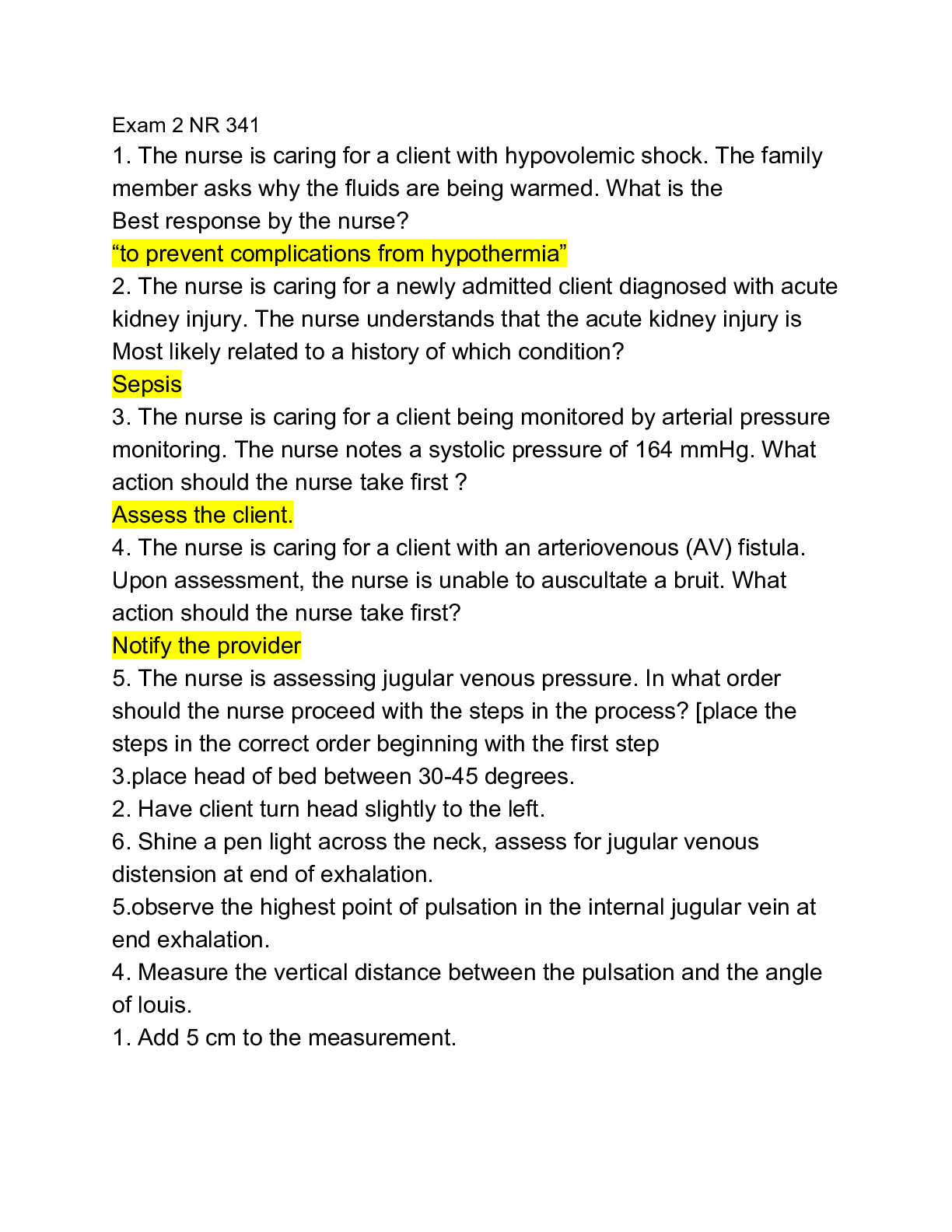
Reviews( 0 )
Document information
Connected school, study & course
About the document
Uploaded On
Jul 27, 2022
Number of pages
9
Written in
Additional information
This document has been written for:
Uploaded
Jul 27, 2022
Downloads
0
Views
36



.png)










